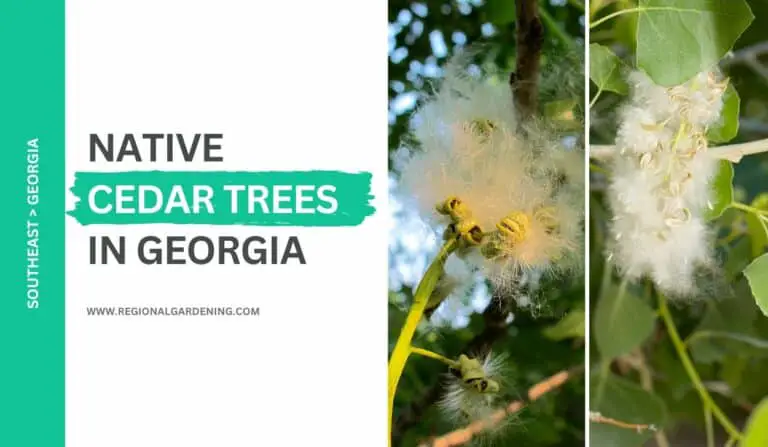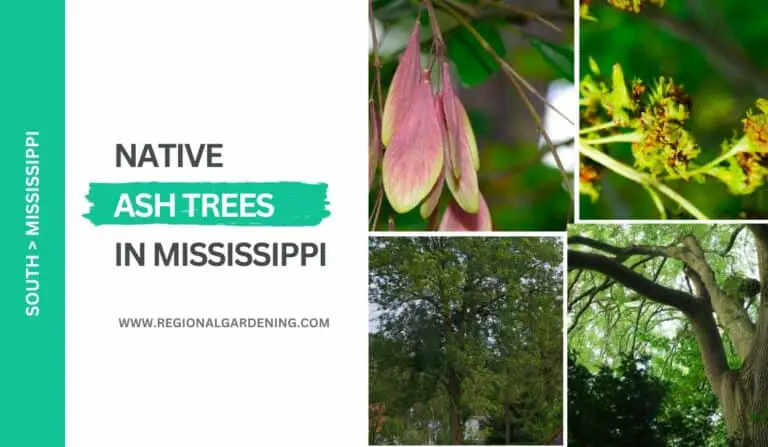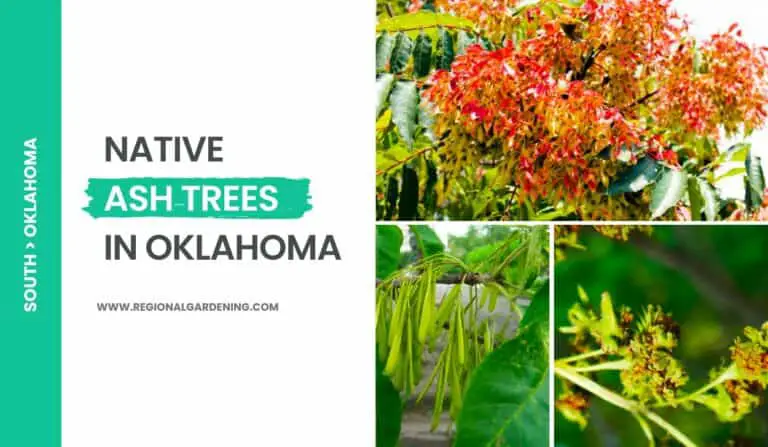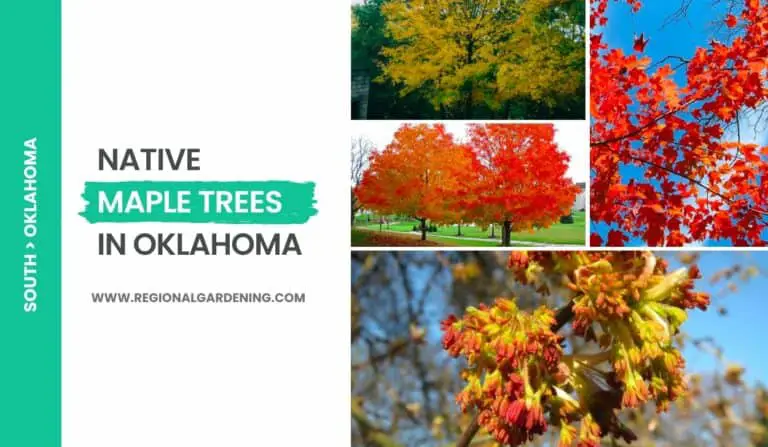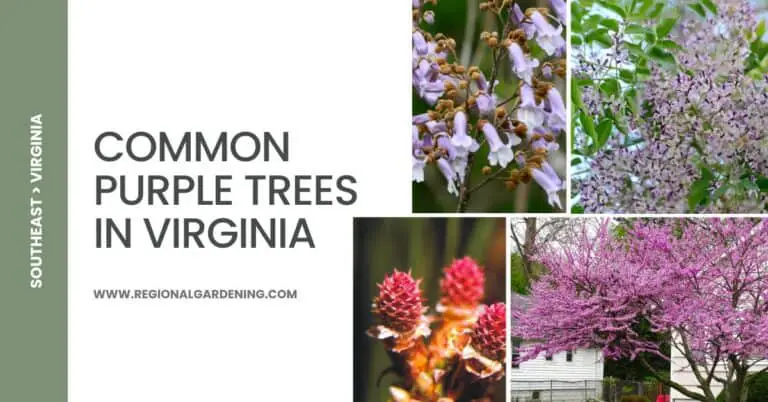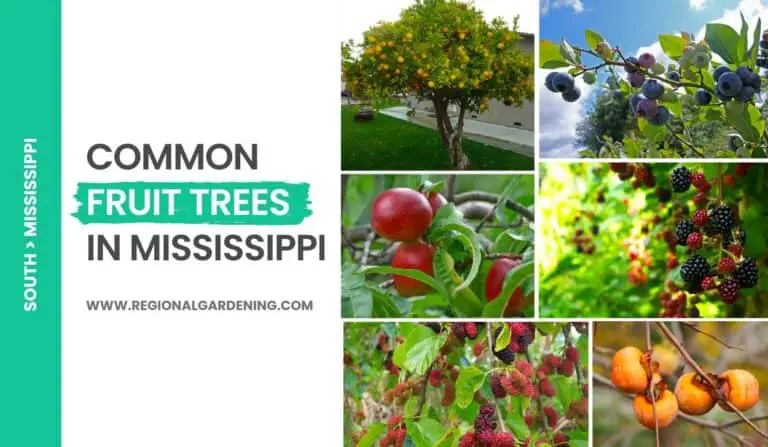10 Native Hickory Trees In Mississippi (With Photos)
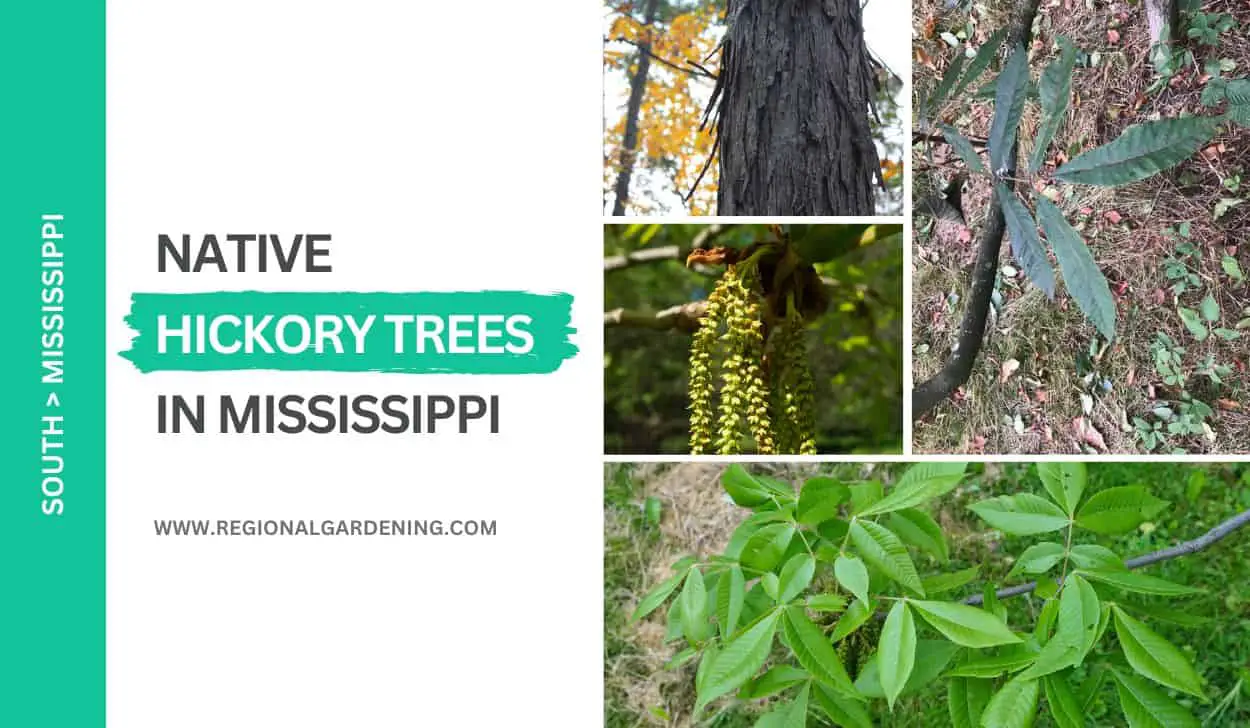
As you wander through the lush forests of Mississippi, the grandeur of native hickory trees towering toward the sky is an awe-inspiring sight that commands attention. These hickory trees have stood as symbols of resilience and strength, with their sturdy trunks and sprawling canopies, an embodiment of endurance.
In this article, we will look closely at 10 native hickory trees in Mississippi, identifying their distinguishing characteristics.
So, let’s begin.
1. Bitternut Hickory
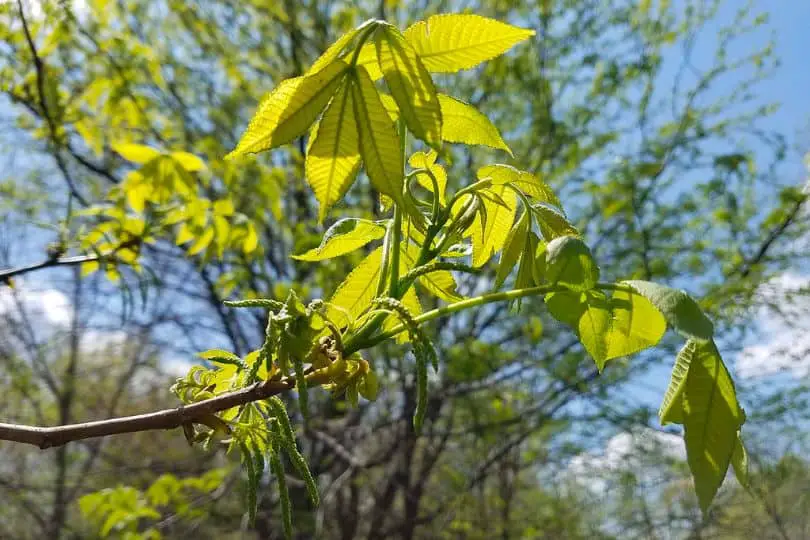
- Common name: Bitternut Hickory
- Scientific name: Carya cordiformis (Wangenh.) K.
- Mature height: Up to 100 feet
- Native range: Southeastern Maine to central Minnesota; south to Florida; west through Kansas and Nebraska to eastern Texas
- Flowers: Yellowish pistillate catkins, green staminate catkins
- Uses: Timber for tools, furniture, paneling, dowels, ladders, charcoal, and fuelwood; ornamental or shade tree.
Bitternut hickory trees are one of the tallest hickory trees in Mississippi landscape and can reach heights upwards of 100 feet. Its leaves are pinnately complex, which means they have numerous leaflets on top and pale green underneath.
The tree produces green staminate catkins and yellowish pistillate catkins. The nuts are globose, reddish-brown in color, and have a slender wing.
Bitternut Hickory trees grow in damp environments including valleys, slopes, and river bottoms. They can withstand a wide range of soil types and pH levels. The tree is also drought and fire-resistant to moderate levels. It prefers to grow in the shadow and cannot live for long periods underwater.
The nuts produced by the Bitternut Hickory are normally not eaten by wildlife, though the bark may be consumed by the rare rabbit, beaver, or small rodent. The tree’s timber is also used to manufacture tools, furniture, paneling, dowels, ladders, charcoal, and fuelwood. Because of its thick lateral roots, it is also regarded as a good species for safeguarding watersheds and restoring degraded lands.
Because of its decorative value and ability to maintain soil, the Bitternut Hickory is a popular tree for landscaping. It has a deep root system that aids in erosion prevention. Early settlers used the tree historically to collect oil from its nuts for use in oil lamps and as a rheumatism treatment.g the tallest hickory trees in Mississippi after Bitternut hickory.
2. Mockernut Hickory
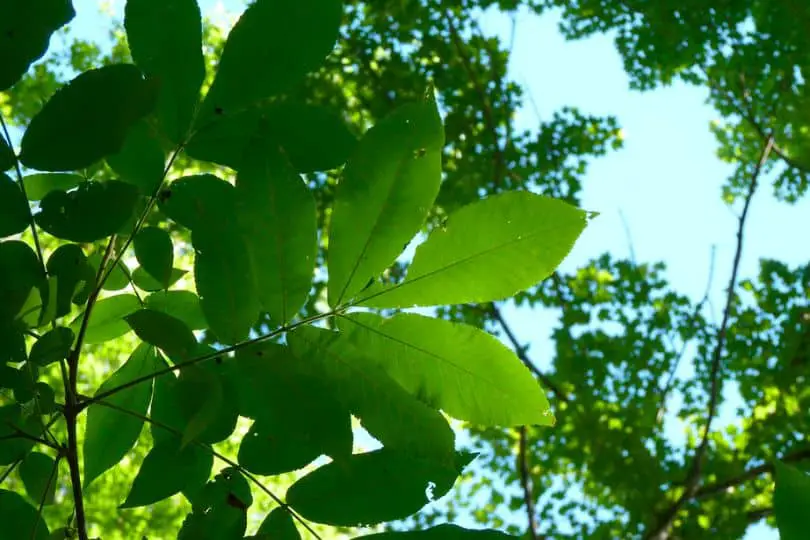
- Common Name: Mockernut Hickory
- Scientific Name: Carya tomentosa Nutt.
- Mature Height: 70.0 feet
- Native Range: Southern Maine through southern Michigan and northern Illinois to eastern Nebraska; south to eastern Texas; west to northern Florida; in Mississippi, throughout except for the Mississippi River Delta
- Flowers: Yellow and red, with staminate flowers in 3-branched catkins and pistillate flowers in 2- to 5-flowered spikes with dark red stigmas.
- Uses: Wildlife habitat, tool handles, agricultural implements, dowels, gymnasium equipment, poles, furniture, lumber, pulpwood, charcoal, and fuelwood.
Mockernut hickory, also known as white hickory, whiteheart hickory, bull nut, or hognut, is a tall tree with pinnately complex leaves ranging in length from 8.0 to 12.0 inches. The leaves have fine to coarsely serrated margins and are dark yellow-green on top and paler on the bottom. The tree’s twigs are sturdy reddish-brown with hirsute, scaly surfaces. The buds are ovoid in shape and tan in hue.
Mockernut hickory fruit is a nut with a reddish-brown husk that is deeply 4-channeled. The nut is oblong-ellipsoidal and measures about 1.0 to 1.5 inches in length. Yellow staminate flowers appear in 3-branched catkins, and dark red pistillate flowers appear in 2- to 5-flowered spikes with scarlet stigmas.
Mockernut hickory can reach a height of 70.0 feet and grows slowly. It is found in the northern region on dry highland slopes, and in Alabama and Mississippi on sandy soils with shortleaf pine and loblolly pine. The tree enjoys deep, fertile soils and can withstand shade, drought, and fire.
Mockernut hickory is highly prized for its timber, which is utilized for a variety of applications including tool handles, furniture, lumber, and fuelwood. It is also a valuable food source for wildlife, with squirrels preferring the nuts and white-tailed deer browsing on them. The tree is an excellent shade tree with a deep taproot, but its slow growth rate is a disadvantage in landscaping.
3. Nutmeg Hickory
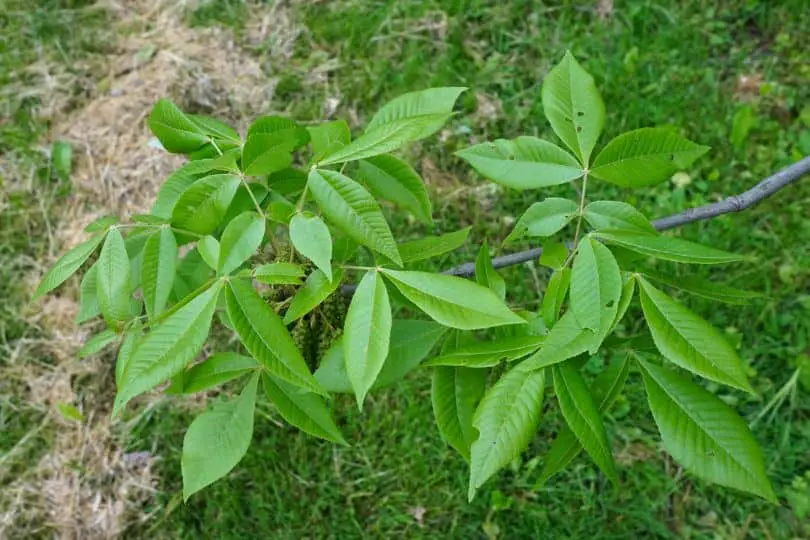
- Common Name(s): Nutmeg Hickory, Swamp Hickory, Bitter Water Hickory
- Scientific Name: Carya myristiciformis (F. Michaux) Nuttall
- Mature Height: Up to 95 feet
- Native Range: Scattered areas in eastern South Carolina, central Alabama and Mississippi, northern Louisiana, southern Arkansas, eastern Texas, and northern Mexico
- Flowers: Produces flowers in the form of catkins.
- Uses: The nuts are eaten by animals, and the tree has attractive bark.
The Nutmeg Hickory, also known as Swamp Hickory or Bitter Water Hickory, has pinnately compound leaves, which means that numerous leaflets are placed along a central stalk. The leaflets range in size from 4.0 to 5.0 inches long and 1.0 to 1.5 inches broad. The leaves are dark green on the outside and silvery white on the inside.
The tree has slender twigs that range in color from brown to bronze. Its buds are tiny and oval, copper in color with a thickly scaly surface. The tree yields 1.5-inch-long nuts with a husk with four ridges. The nuts are ellipsoidal or slightly oblong with a dark reddish-brown tint.
The Nutmeg Hickory can reach a height of 95 feet and grows slowly. It is most commonly seen on the sides of rivers and wetlands in rich, moist soil. It prefers soil with a pH between 4.5 and 6.5. The tree is indigenous to the southeastern United States and northern Mexico.
Squirrels and other animals enjoy the nuts produced by the Nutmeg Hickory. The tree also has appealing bark and can tolerate a variety of soil conditions, making it perfect for landscaping. However, it grows slowly and is considered an uncommon species. When located in the landscape, it should be maintained and protected.
Nutmeg hickory trees are among the tallest hickory trees in Mississippi after Bitternut hickory.
4. Pignut Hickory
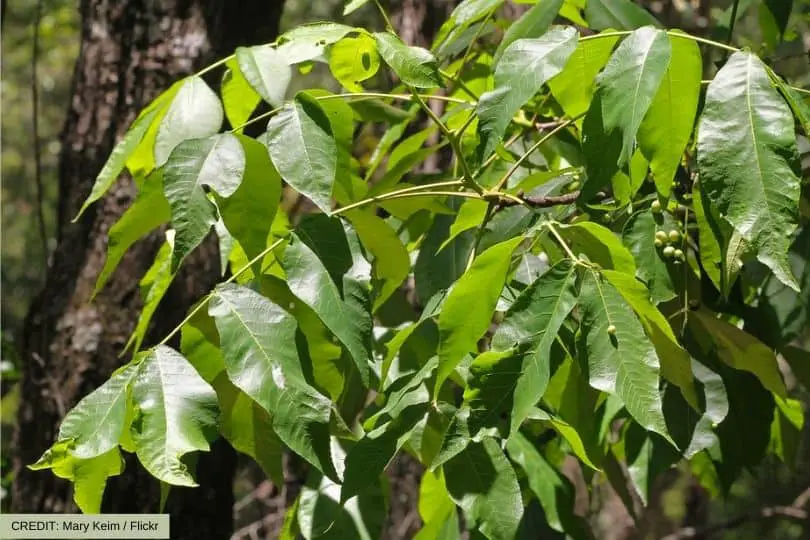
- Common Name: Pignut Hickory
- Scientific Name: Carya glabra (P.Mill.)
- Mature Height: 75.0 feet
- Native Range: Illinois, Missouri, Arkansas, Louisiana, Florida, Pennsylvania, New York, Vermont, Mississippi
- Flowers: Yellow catkins, small sweet nuts
- Uses: Wildlife food, wood used for sporting goods, agricultural implements, tool handles, and furniture.
The Pignut Hickory, also known as sweet pignut, coast pignut hickory, broom hickory, or smoothbark hickory, is a kind of tree that can reach heights of 75 feet. Its leaves are pinnately complex, which means they have several leaflets and are yellow-green on top and paler on the bottom. The tree has sturdy reddish-brown twigs and ovoid to almost spherical buds. Squirrels, chipmunks, bears, and many birds enjoy the little sweet nuts produced by the Pignut Hickory.
The Pignut Hickory is typically found in the wild on upland slopes and ridges, but it can also grow in bottomland areas. This tree favors medium to fine-textured soils and can survive a wide range of pH levels; it is shade-tolerant but not tolerant of wet or flooded situations. Pignut Hickories can live for more than 50 years and develop slowly.
The Pignut Hickory has several applications for people in addition to supplying food for wildlife. Because its wood is robust, resistant, and elastic, it is ideal for sporting items, agricultural tools, tool handles, and furniture. People utilized the tree to make broom handles, skis, wagon wheels, and even vehicle parts in the past.
Although the Pignut Hickory is not typically utilized in landscaping, it is drought-tolerant and adaptable to a wide range of soil conditions. When planted among evergreen oaks, it gives texture variation and has wonderful fall color, turning yellow. It also resists wind and frost damage.
5. Red Hickory

- Common Name: Red Hickory or Sweet Pignut
- Scientific Name: Carya ovalis Sarg. (C. glabra var, odorata)
- Mature Height: 75.0 feet
- Native Range: Central Iowa to northeastern Arkansas, northern Mississippi, northern Alabama, northern Georgia, and central New York
- Flowers: Yellowish flowers in catkins for males and spikes for females
- Uses: Used for timber and similar purposes as other hickories
The Red Hickory tree, popularly known as the Sweet Pignut, has pinnately complex leaves. It has 5 to 7 leaflets that are 6.0 to 7.0 inches long and 1.0 to 2.0 inches wide, and its leaves are 6.0 to 10.0 inches long. The leaves are dark yellow-green on top and lighter on the bottom. Slender reddish brown twigs with slightly pubescent or glabrous surfaces characterize the tree. It has ovoid buds that are reddish brown in hue and have shiny surfaces.
Yellowish blooms and ellipsoidal nuts are produced by the Red Hickory. The flowers are monoecious, which means they have separate male and female parts. Males have green, hairy catkins, while females have 1- or 2-flowered spikes. The nuts are 1.0 inches long, oblong in shape, and green or brown, with a husk and a delicious seed.
This tree can reach a height of 75.0 feet and grows slowly. It is native from central Iowa to central New York, and south to northeastern Arkansas, northern Mississippi, northern Alabama, and northern Georgia. It grows in highland mixed woods and can handle a wide range of soils and conditions, but thrives on cool, damp slopes.
Although the Red Hickory is not as good in quality as other related hickories, it is nonetheless used commercially for timber and other purposes. It, like the C, can also be utilized in landscaping. The glabra variety. Some consider it a unique species, while others believe it is a variation or is not worthy of its classification.
6. Sand Hickory
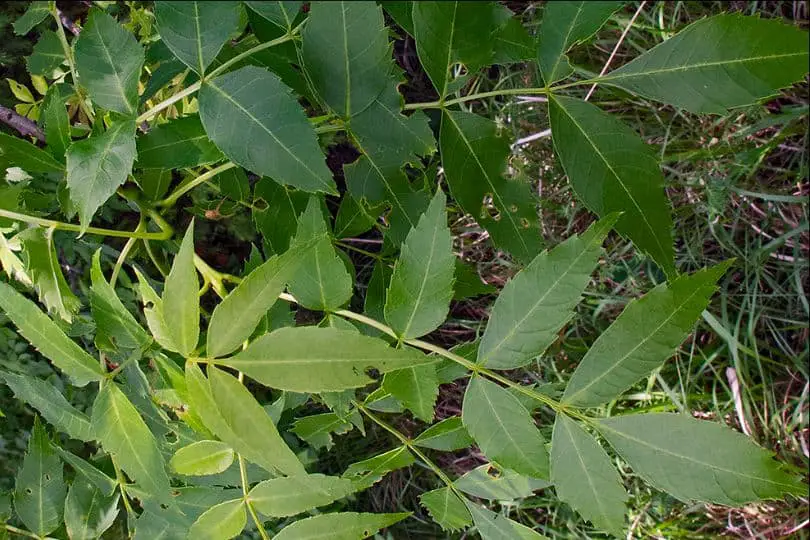
- Common Name: Sand Hickory
- Scientific Name: Carya pallida Engl. & Graebn.
- Mature Height: 30.0’ – 40.0’ (occasionally 90.0’ – 110.0’)
- Native Range: Throughout North America
- Flowers/Cones/Fruit: Flowers are monoecious and unisexual, with staminate catkins.
- Uses: Wildlife value, timber, and fuelwood.
The Sand Hickory, scientifically known as Carya pallida, is one of the shortest hickory trees in Mississippi that may grow up to 30.0 to 40.0 feet tall, with occasional heights of 90.0 to 110.0 feet.
It has pinnately complex leaves that range in length from 7.0 to 15.0 inches and have 7 to 9 leaflets. The majority of the leaflets are seven in number, with the terminal leaflet being 4.0 to 6.0 inches long and 1.0 to 2.0 inches wide. The leaves are light green on top and paler green on the bottom, with a shiny sheen on top and silver flecks below.
The Sand Hickory’s twigs are slender and can be red-brown or glabrous. Terminal buds are 0.25 inches long, and laterals are even shorter. The tree produces monoecious blooms with densely hairy staminate catkins 2.5 to 5.0 inches long. The pistillate flowers are solitary and rectangular, with golden scales covering them.
The Sand Hickory grows in a variety of habitats, including Cape May, New Jersey, the upper Coastal Plain, and Piedmont Plateau, and as far south as Florida. It also spreads west through the Gulf states, with reports from Tennessee to Mississippi. The tree grows best in damp places with full sun and prefers sandy soils.
While the Sand Hickory has little economic worth as a timber species, it is nonetheless useful for its wildlife advantages and can be used as fuelwood.
It is a slow-growing species with a life expectancy of more than 100 years. Because of its thick taproot, the tree is difficult to transplant. Furthermore, the Sand Hickory’s inner bark contains astringent characteristics and has been used to treat cuts and as a mouthwash for sore lips.
7. Shagbark Hickory
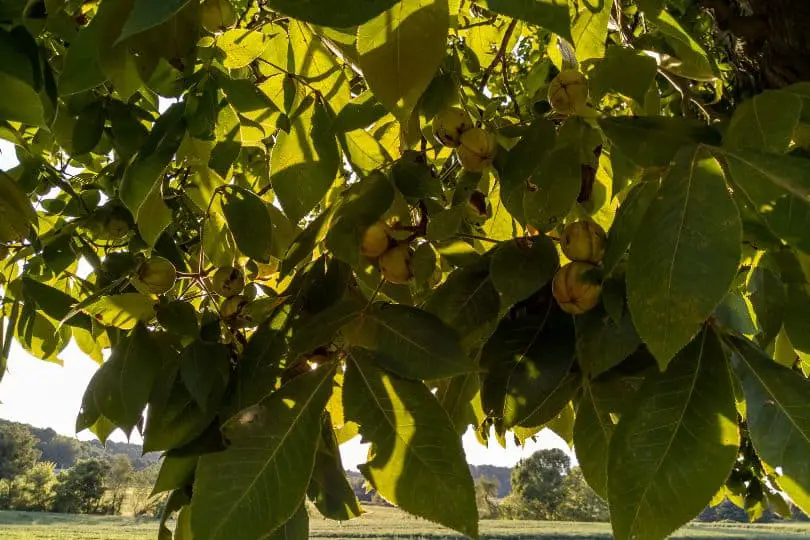
- Common name: Shagbark Hickory
- Scientific name: Carya ovata (Mill.) K. Koch
- Mature height: 80.0 feet
- Native range: Eastern US
- Flowers/cones/fruit: Yellow-green, hairy catkin flowers
- Uses: Wildlife food, furniture, flooring, tool handles, ladder rungs, sporting goods, fuelwood, charcoal, and smoking meat.
Shagbark Hickory (Carya ovata) is a tall tree that can reach a height of 80.0 feet when fully grown.
This tree can be found throughout the Eastern United States, from southern Nebraska to southeastern Minnesota and south to Georgia. It can also be found in the mountains of northeastern Mexico. The tree has deciduous pinnately complex leaves that fall off during particular seasons.
The leaves are yellow-green on top and paler on the bottom, with serrated margins and pubescent teeth. The twigs of the tree are thick and orange-brown in hue, with big orange lenticels. The buds are dark brown and broadly oval.
Flowers and fruit are produced by Shagbark Hickory. Because the blooms are monoecious, they have both male and female structures. The staminate flowers are hairy and yellow-green, and they form catkins. Pistillate flowers, on the other hand, are rusty crimson and fuzzy, growing in spikes.
The tree also produces thin-shelled nuts that range in hue from light brown to pale brown. The husk that surrounds the nut is thick and dehiscent, which means it opens to reveal the nut. When young, the bark of the Shagbark Hickory tree is bluish to slate gray, but as it ages, it turns shaggy, with broad vertical plates that curve out from the trunk.
Shagbark Hickory has a variety of functions in both natural and human activities. Animals such as bears, foxes, mice, rabbits, turkeys, ravens, woodpeckers, and others feed on the nuts produced by this tree.
The tree’s wood is robust and long-lasting, making it ideal for furniture, flooring, tool handles, ladder rungs, and sporting items. It’s also used for fuel, charcoal, and smoking meat. Because of its sluggish growth rate, it is not typically planted as a landscaping tree, but it has been utilized for the rehabilitation of disturbed sites.
Because of its great strength and resilience, Shagbark Hickory wood was once utilized to construct wheels and spokes for wagons, carriages, carts, and early vehicles.
8. Shellbark Hickory
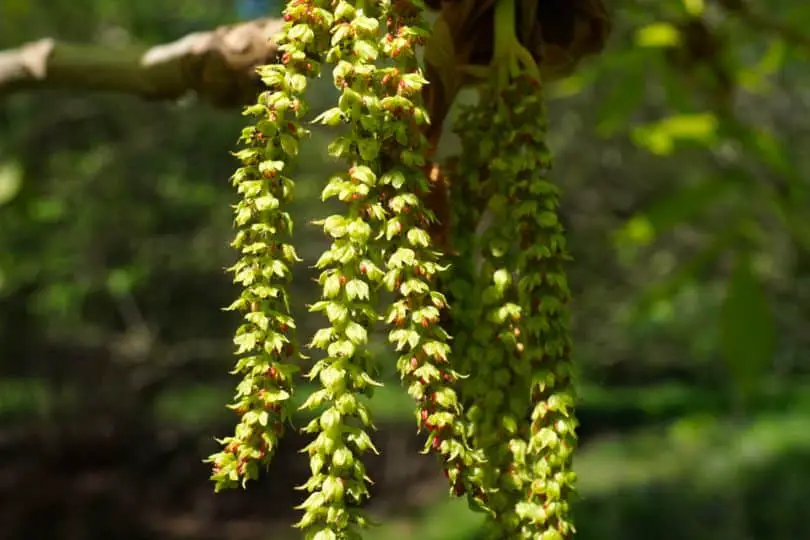
- Common Name: Shellbark Hickory
- Scientific Name: Carya laciniosa Schneid.
- Mature Height: Up to 100 feet
- Native Range: From Maine to Minnesota and south to Texas and Florida
- Flowers: Yellow catkin flowers
- Uses: Wildlife food, furniture, flooring, tool handles, ladder rungs, sporting goods, fuelwood, charcoal, and sometimes crossed with pecans to produce Hicans.
The Shellbark Hickory, also known as Carya laciniosa Schneid, is a tall tree that can reach a height of 100 feet. It has big leaves with 5-9 leaflets that can grow up to 24 inches long. The leaves are dark green on top and yellow-green on the underside. Ducks, quail, wild turkeys, squirrels, and other animals eat the nuts produced by the tree.
The Shellbark Hickory’s bark is light gray and fissured, separating into thick, broad plates. It is usually found on upland slopes and flats in deep, rich, moist soils. It favors alluvial soils and may survive shade and slight drought. This tree is widespread but not particularly common.
Shellbark Hickory nuts are enormous and flavorful, and they can be as large as walnuts. This tree’s wood is used to create furniture, tool handles, sporting goods, veneer, fuelwood, and charcoal. Because the tree is resistant to snow and ice damage, some people utilize it as landscaping.
Interestingly, Cherokee Indians employed Shellbark Hickory as a natural medicine for pain relief, gastrointestinal disorders, and general ailments. Overall, the Shellbark Hickory is an important tree that supplies food and resources to a variety of creatures and humans.
9. Southern Shagbark Hickory
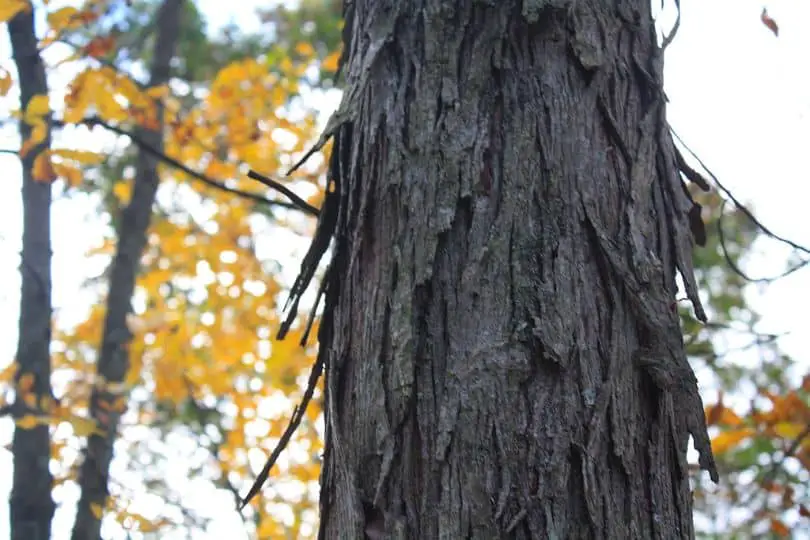
- Common name: Southern Shagbark Hickory
- Scientific name: Carya carolinae-septentrionalis (Ashe)
- Mature height: 80.0′
- Native range: Central North Carolina to northern Georgia, through western North Carolina to eastern Tennessee, in Cullman and Dallas Counties, Alabama, and eastern Mississippi
- Flowers/cones/fruit: Yellow catkins, rusty red woolly spikes
- Uses: Food source for many wildlife species.
The Southern Shagbark Hickory, sometimes known as the Carolina Hickory, is a tree that can reach heights of 80 feet. Carya carolinae-septentrionalis is its scientific name.
This tree’s leaves are pinnately complex, which means they have numerous leaflets arranged in a feather-like pattern. These leaves have a dark green top and a yellow-green underside. As flowers, the tree produces yellow catkins and rusty red woolly spikes. A thick husk that covers its nuts rips open to reveal pale brown to white nuts inside.
The Southern Shagbark Hickory is native to North Carolina, Georgia, and sections of Alabama, Mississippi, and Tennessee. It prefers dry limestone hills, river bottoms, and low-flat forests to flourish. The tree can endure some shade and severe drought, but it does not thrive in poor drainage areas.
Many wildlife species, including squirrels, chipmunks, bears, foxes, rabbits, and mice, rely on the nuts of the Southern Shagbark Hickory. This tree’s wood is rarely used for timber because it accounts for a small fraction of a forest stand and is frequently mixed with shagbark hickory.
Because of its sluggish growth, the Southern Shagbark Hickory is ideally suited for parks and big estates in landscaping. Native American cultures used the nuts of this tree to produce bread and cakes in the past. The sap of the tree, like that of sugar maple trees, can be utilized to manufacture sugar and syrup. Overall, the Southern Shagbark Hickory is a valuable tree for animals and has traditional applications in food and syrup production.
10. Water Hickory
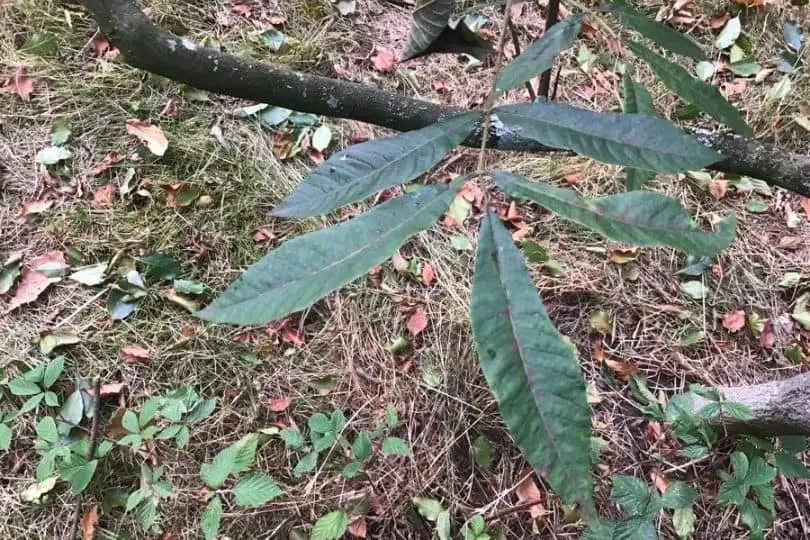
- Common Name: Water Hickory
- Scientific Name: Carya aquatica (F. Michaux) Nutt.
- Mature Height: Up to 100 feet
- Native Range: Atlantic and Gulf Coastal Plains from southeastern Virginia to southern Florida; west into eastern Texas, and the Mississippi Valley; north to southern Illinois
- Flowers/Cones/Fruit: Yellow, 3-branched catkins for staminate flowers; solitary or clustered pistillate flowers
- Uses: Cleansing drainage water, providing refuge for threatened species, nuts used by wildlife, primarily waterfowl, and wood ducks.
The Water Hickory is a tree that can reach heights of 100 feet. It has 9-17 leaflets on pinnately complex leaves. The leaves are dark green on the outside and brown on the inside. The twigs are slender and brown, reddish brown, or black. The staminate blooms are 3-branched golden catkins, while the pistillate flowers are grouped. The nuts are dark and oval.
Water Hickory trees can be found from Virginia to Florida on the Atlantic and Gulf Coastal Plains. They prefer soil that is wet but well-drained. The tree is well-known for cleaning drainage water and providing a habitat for threatened species. Waterfowl and wood ducks consume the nuts, but mammals are not fond of them.
Because of its dimensional instability, Water Hickory has little economic value as lumber, but it can be utilized as fuelwood. It resembles a smaller form of the pecan tree and can be planted in landscaping to improve drainage.
It is critical to understand that Water Hickory differs from the farmed pecan tree. Unlike the pecan tree, the water hickory has pubescent leaves and flattened nuts. Bitter Pecan is a hybrid that is a cross between the Water Hickory and the pecan tree.
Similar Articles
- Native Flowering Trees In Mississippi
- Common Fruit Trees In Mississippi
- Native Pine Trees In Mississippi
- Common Palm Trees In Mississippi
- Native Oak Trees In Mississippi
- Native Maple Trees In Mississippi
- Common Birch Trees In Mississippi
- Native Elm Trees In Mississippi
- Native Magnolia Trees In Mississippi
- Native White Flowering Trees In Mississippi
- Common Pink Flowering Trees In Mississippi
- Native Purple Trees In Mississippi
- Native Plum & Cherry Trees In Mississippi
- Native Ash Trees In Mississippi
- Native Cypress Trees In Mississippi
- Native Nut Trees In Mississippi
Native Hickory Trees In Mississippi – Sources
The Regional Gardening team makes sure that the information in our articles is accurate by only using sources that are known to be trustworthy. Some of these sources are peer-reviewed journals from government agencies, well-known universities, and scientific research organizations.
- Native Trees For Mississippi Landscapes, Mississippi State University Extension.
- Mississippi Trees, Publications Of Mississippi Forestry Commission.
- Department Of Plant & Soil Sciences, Mississippi State University Extension.
- Tree Care, Mississippi Urban Forest Council.


